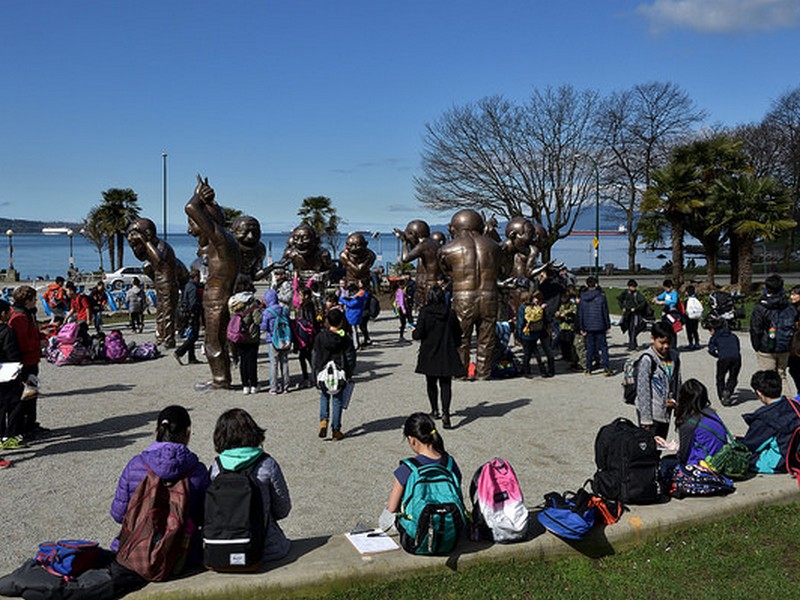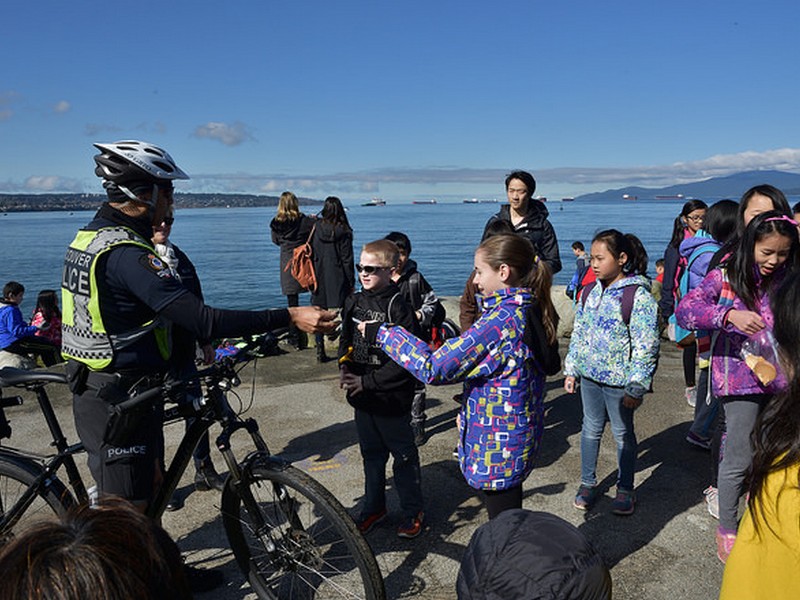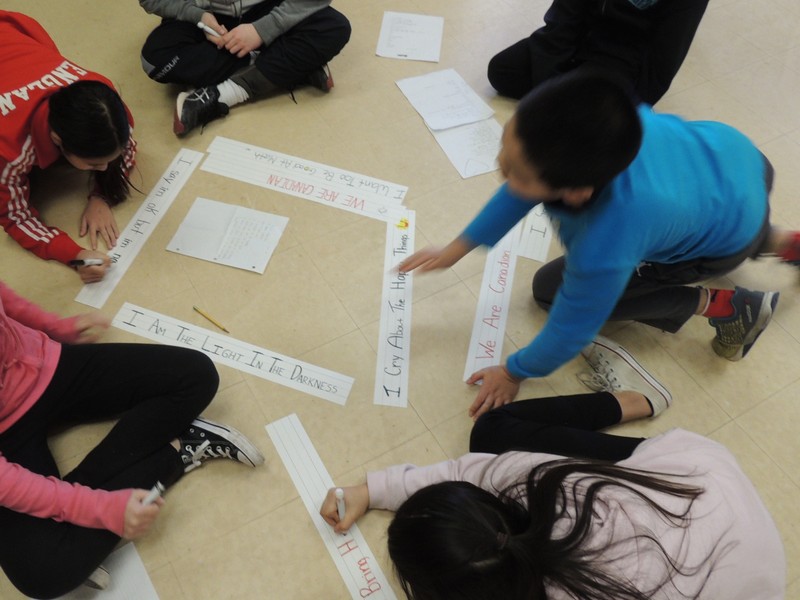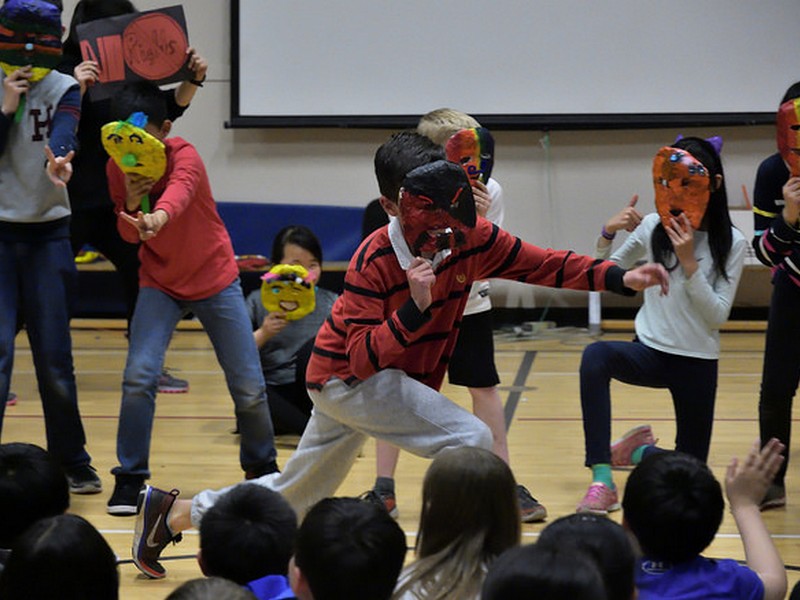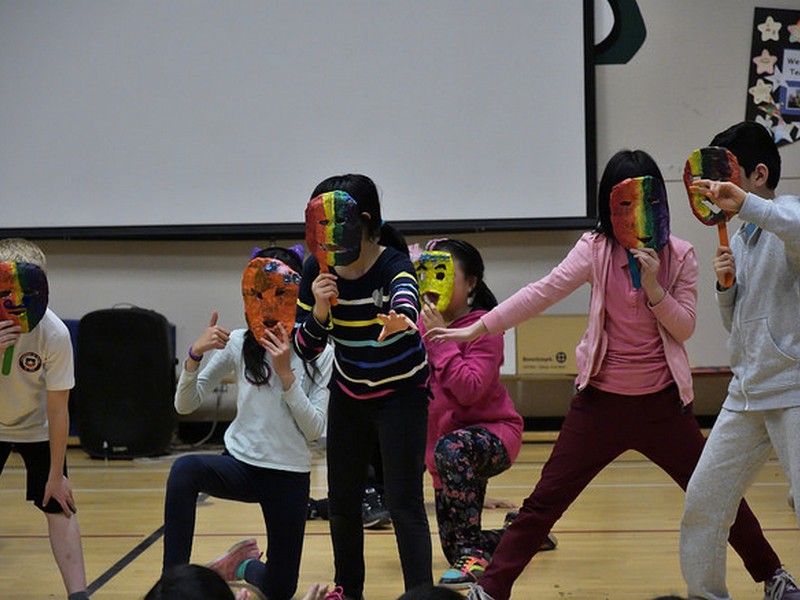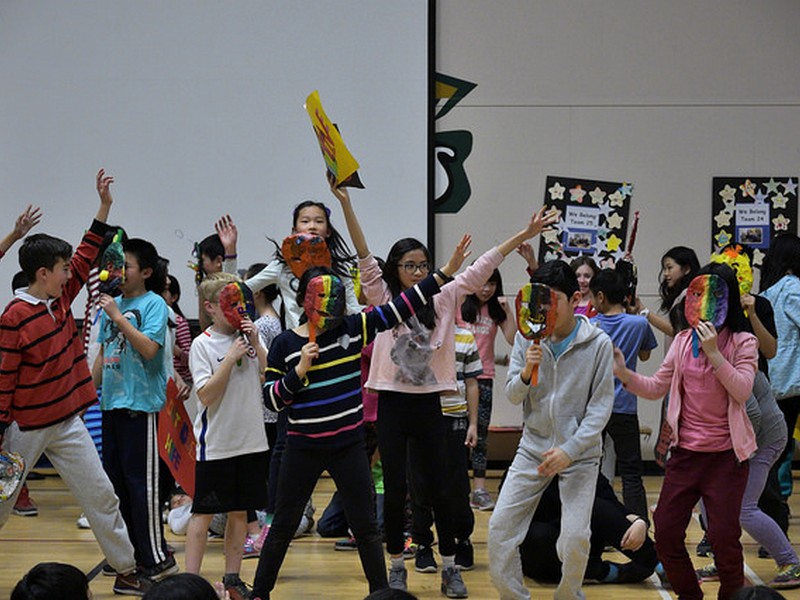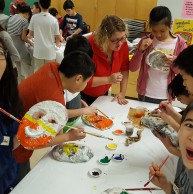General Currie Elementary: Exploring Identity
Arts Education, Language Arts, Social Studies
School: General Currie Elementary, Richmond
Teacher: Sara Mais, Jane Stahl, Jamie Campbell
Artist Collaborators: Lori Sherritt-Fleming
Class: Grade 4/5, 5/6, and 6/7
Overview
Students embarked on a journey of inquiry, exploring how external influences of people, places and things form identity as an individual, a community, a nation and a global citizen, and how these identities evolve. The students explored identity, how they express themselves, choices, empathy and inclusion in relation to two Biennale installations, A-Maze-Ing Laughter and Engagement. A variety of art forms including creative writing/poetry, spoken word, drama, dance, mask making and mask work, photography and publishing using i-pads and book creator were used to engage the students throughout the learning process.
Connection to the Vancouver Biennale Exhibition
Through these installations and other resources students explored the theme of self identity and the various factors that influence identity
A-maze-ing Laughter – connecting the art to freedoms of expression, human interconnectedness. Unpacking the masks we wear?
Engagement – Exploring the meaning of the sculpture and its placement in the community has meaning. Discuss gender roles, women’s rights, gender identity LGBTQ – social justice. How has art evolved over time?
BIG IDEAS
Social Studies (Grades 4-7) – Engaging in creative expression and experiences expands people’s sense of identity, belonging and community.
Guiding Questions
What influences our identity?
How does art/media/literature/language shape our identity?
How does place influence our identity?
How can artwork reflect identity?
What does it mean to be a Canadian/global citizen?
What are Indigenous people’s influences on Canadian identity?
How has Canada’s identity been shaped by immigration of individuals from a wide range of ethnic and cultural backgrounds?
What are the rights and responsibilities of a Canadian/global citizen?
How might our actions have consequences for others locally or globally?
Cross-Curricular Access
Social Studies: Students learn how immigration and multiculturalism continue to shape Canadian society and identity. Students explored how Canada’s policies and treatment of minority peoples have negative and positive legacies.
Language Arts: Expose students to various pieces of literature (excerpts from novels, graphic novels, picture books, oral storytelling, etc.) to explore how people from different cultures, races, genders, classes, sexual orientations and religions are similar, exploring the themes of acceptance and human interconnectedness. How might similarly themed literature and artwork connect people across borders? Students explore the idea that interconnection is at the core of Indigenous ways of knowing.
Arts Education: Students engage in creative expression and experiences to expand their sense of identity and community.
Learning Process/Inquiry Challenges
Students study the history and geography of the local community. They explore the local Indigenous population past and present.
Students use multiple forms of text that allow them to explore story to help understand themselves and make connections to others, including Indigenous and non-Indigenous peoples, and to the world. They respond to text in personal, creative and critical ways. Students construct meaningful personal connections between the texts, ourselves and our place.
Students exchange ideas and viewpoints to build shared understanding and extend thinking.
Students transform their connections into a literary/visual art piece through playing with words to create individual identity poems. Through collaborative creation and performance of “I Am Canadian” poems, students learned and applied the power of language.
Students developed strong and confident voices through expressing themselves through performance poetry.
Students connected with the project BIG IDEAS through visual art expression and created themed paper mache masks.
Students learned to express the theme of identity through dance in conjunction of the use of prop (masks).
Student Creation
Wrote and performed identity poetry based first on themselves, individually, and then on being Canadian, in small groups.
Constructed, designed, painted and learned to use in a performance, paper mache masks themed around Youth, Oppressors and Helpers.
Grade 6/7 students constructed masks the face they show the world vs and the face they keep hidden (their masks).
Grade 4/5 students worked on the choreograph and performed a dance piece to express choices, their right to have rights, what happens when their rights are taken away and how they can get them back.
Learned the art of photography and skills including how to use different angles and to publish.
Published their own original books using i-pads and Book Creator.
Students created I Am poetry with visuals. Read this sample I Am poem.
Reflection
Teachers – Jane Stahl, Jamie Campbell and Sara Mais
We found the Biennale project to be such a positive experience for all involved. It was a pleasure to work collaboratively with our Biennale artist, Lori Sherritt-Fleming, who brought her expertise, enthusiasm and flexibility to our weekly sessions. Lori was very much aware of the students’ individual needs, and was careful to create a safe, accepting environment where our students could take risks and explore their creative side. She was continually adapting and tweaking lessons as our inquiry evolved. Lori ensured the activities were inclusive and accessible to all students, and considered the wide range of ages, abilities and personalities; even the most anxious of students were able to participate in some way. We saw notable growth in students’ self-confidence, in their acceptance of others, and in their ability to express themselves and to perform in front of an audience. Throughout the project, Lori worked to fully engage the students and challenge them in their thinking. Our students were provided with many opportunities for creative expression, including: spoken word, poetry, drama, creative movement, mask making, photography and digital storytelling, all of which were showcased in our final performance. Our students raved about our field trip to see the art installations, “A-maze-ing Laughter” and “Engagement”, and impressed us with their careful observations and thoughtful reflections. By the end of our project, we were delighted with the growth we saw in our students. Overall, we feel very fortunate to be a part of the Biennale experience and hope to work with them again in the future.
Students
Jessica
“It was cool learning about myself and other people. I loved making the double-sided masks because it’s fun to show your inside and your outside.”
Sklyer
“It was fun playing the games like Zip Zap Zoom to watching the younger kids be so funny during the performance.”
Aniket
“We learned about our identity, that even though people might laugh, you just gotta be yourself.”
Aaron
“I liked it because it made me feel crafty because I’ve never really got to do much arts stuff like that before. It was hard trying to write the poem but I felt pretty good about it when I finished. Ms. Lori was always calm and nice. She wasn’t strict and she never forced anyone to do anything if they didn’t want to.”
Emma
“I learned about difference aspects of identity and what makes a person them. It helped me be more confident and accept that nothing has to be perfect and to just be myself. My best memory was when we were all in the class laughing and learning about different types of photography.”
Artist – Lori Sherritt-Fleming
As part of our Big Ideas Biennale project at General Currie Elementary, grade 4-7 students asked big questions about who they are and who we are collectively as Canadians.
Using the many tools of a writer: repetition, similes, metaphors, descriptive language, rhythm, rhyme,voice…we wrote together. Some think that writers create in isolation, but these poems reflect discussion, collaboration and many voices celebrated in one piece.
Students took the poems they had written about themselves and their identities from a former class and selected their favourite lines. They then moved to larger groups and, using those lines, wrote them on strips of paper, laying them out to create new poems, restructured slightly to reflect the theme of ‘us as a nation’. As a finale, students performed the poems using tableau and spoken word.
Their work was mighty and moving, insightful and inspiring. The creativity that emerged was worthy of being shared on a national and international level. It would be interesting to do this activity with students in other countries and explore the similarities and differences between voices across the globe.
Some of the most difficult questions for anyone at any age to answer are: Who am I? Where do I fit in? What is my culture and how do I express it?
Our theme with Biennale was exploring identity in all of its shape, sizes and disguises and the factors that influence it. Using drama, spoken word, mask making, digital photography and technology (Book Creator on i-pads), we mined our inner artists and discovered ways in we could share our feelings, thoughts and concerns in the hopes of finding connections in our diversity and empathy and enlightenment to bridge what may or has divided us. These are definitely BIG IDEAS.
Students visited the Biennale installations A-maze-ing Laughter and Engagement in Vancouver’s West End to inspire and inform our explorations. How do we relate to one another? What makes us the same? Different? What language does laughter come in? What is ‘relationship’ and how can we strive to improve our relations at home and abroad?
We began with who we are, the hope being that in understanding ourselves and those closest to us, we can then venture into imagining ourselves as others and tapping into their voices…the voices of immigrants, refugees, historical characters, a community of people then and now, as well as build positive visions for the future.
Using drama and the I Am Poem format, all students dove deep. Many of the student poems struck me, many words and phrases provided perspective into the hearts of my neighbours. The one attached, in particular. Written by a grade seven student, it captures, not only her present day experience, but what could have been the experience of those who went to residential school or those Japanese Canadians who were displaced during the war. It speaks to feelings we all feel as humans and to hope. So profound, moving and beautiful, this word…hope.
I witnessed all of these students transform, connect and grow through their experience with Biennale. I witnessed the power of art to connect, to heal, to inform and to provide a forum for safe inquiry and the development of personal voice.
Lori Sherritt- Fleming’s Blog Post
January, 2017
Some of the most difficult questions for anyone at any age to answer are: Who am I? Where do I fit in? What is my culture and how do I express it?
As part of Vancouver Biennale’s Big Ideas project http://www.vancouverbiennale.com/learn/ I am working with grade 4-7 students and teachers at General Currie Elementary school in Richmond. Our theme is exploring identity in all of its shape, sizes and disguises and the factors that influence it. Using drama, spoken word, mask making, digital photography and technology (Book Creator on i-pads), we are mining our inner artists and discovering ways in which to share our feelings, thoughts and concerns in the hopes of finding connections in our diversity and empathy and enlightenment to bridge what may or has divided us. These are definitely BIG IDEAS.
We will be visiting the Biennale installations A-maze-ing Laughter and Engagement in Vancouver’s West End to inspire and inform our explorations. How do we relate to one another? What makes us the same? Different? What language does laughter come in? What is ‘relationship’ and how can we strive to improve our relations at home and abroad?
We began with who we are, the hope being that in understanding ourselves and those closest to us, we can then venture into imagining ourselves as others and tapping into their voices…the voices of immigrants, refugees, historical characters, a community of people then and now, as well as build positive visions for the future.
Using drama and the I Am Poem format, all students dove deep. Many of the student poems struck me, many words and phrases provided perspective into the hearts of my neighbours. The one below, in particular. Written by a grade seven student, it captures, not only her present day experience, but what could have been the experience of those who went to residential school or those Japanese Canadians who were displaced during the war. It speaks to feelings we all feel as humans and to hope. So profound, moving and beautiful, this word…hope. Enjoy.
February, 2017
As part of our Big Ideas Biennale project at General Currie Elementary, grade 4-7 students have been asking big questions about who they are and who we are collectively as Canadians.
Using the many tools of a writer: repetition, similes, metaphors, descriptive language, rhythm, rhyme, voice…we wrote together this week. Some think that writers create in isolation, but these poems reflect discussion, collaboration and many voices celebrated in one piece.
Students took the poems they had written about themselves and their identities from a former class and selected their favourite lines. They then moved to larger groups and, using those lines, wrote them on strips of paper, laying them out to create new poems, restructured slightly to reflect the theme of ‘us as a nation’. As a finale, students performed the poems using tableau and spoken word.
Their work is mighty and moving, insightful and inspiring. Only a couple of examples are featured here, but the creativity shown is worthy of being shared on a national and international level. I did suggest we bring in the Prime Minister to hear them perform these.
It would be interesting to do this activity with students in other countries and explore the similarities and differences between voices across the globe.
I hope you are as inspired as I was!
Credits
Performance Event Photo Credits: Roaming-the-planet
